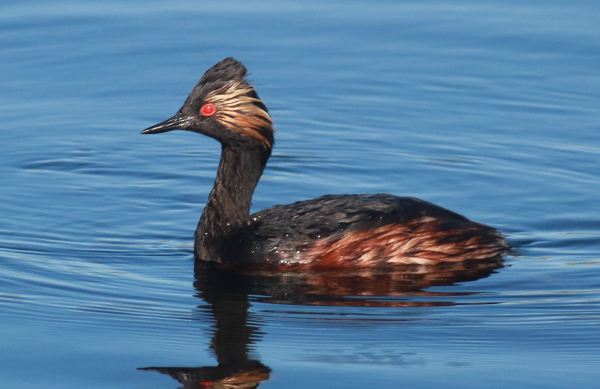
During a recent fall census, biologists estimated that more than 3.2 million Eared Grebes were foraging in the lake – that’s more than 85 percent of the North American population (photo by Paul Konrad)
|
Expansive numbers of shorebirds, wading birds, and waterfowl being reported at Great Salt Lake continue to impress birders and biologists alike. For example, last July biologists with the Great Salt Lake Ecosystem Program (GSLEP) counted 122,850 Wilson’s Phalaropes on the lake, accounting for more than 8 percent of the total North American population. And during a recent fall census, biologists estimated that more than 3.2 million Eared Grebes were foraging in the lake – that’s more than 85 percent of the North American population.
Established with the purpose to manage and conserve the birds and aquatic communities of the Great Salt Lake, GSLEP has monitored migratory shorebirds, wading birds, waterfowl, and other waterbirds at specific locations within the lake since 1997. The locations surveyed represent areas with particularly large concentrations of birds that occur predominantly in the Bear River Refuge, Farmington Bay, and Ogden Bay. The resulting dataset collected by GSLEP biologists and volunteers is among the longest-running annual count datasets for wetland sites in the western United States.
This unique dataset offers the opportunity to assess beyond impressively large counts to understand how bird numbers have changed in the surveyed areas over time. Audubon entered into a collaborative agreement with GSLEP to analyze changes in counts (trends) for 30 species and 7 species groups, and to relate census totals to water conditions.
During the period from 1997 to 2017, almost without exception, the total number of birds counted across areas surveyed by GSLEP remained unchanged or they increased during spring and fall for the 37 species and groups analyzed. It is important to note that these trends do not apply to Great Salt Lake as a whole, just to those areas surveyed by GSLEP. Some habitats, such as shorebird playa habitat, may be under-represented within the surveyed areas. Additional study will be required to understand why counts were stable or increased, considering that these trends don’t necessarily indicate that habitat conditions were stable or improving in the surveyed areas.
Regionally across western North America, assessments indicate that surface water resources are declining. With declining regional conditions, birds may be pushed into the surveyed areas at Great Salt Lake because they are running out of optional habitats. Coordinated monitoring of birds and habitats across the region will be required to evaluate the effects of regional wetland conditions on bird use of the areas surveyed at Great Salt Lake.
For this reason, Audubon strongly supports the recently introduced federal legislation to conduct a regional scientific assessment of saline lakes. The numbers of birds, along with the stable and positive trends at Great Salt Lake, suggest that the surveyed areas continue to provide important habitat for migrating birds that must be conserved to support key species. However, setting specific objectives and management plans for shorebirds, wading birds, and waterfowl will be key to securing the habitat and food sources for the future.
While total numbers were mostly stable or increasing, the analyses did reveal specific areas where counts for species or groups declined. For example, Franklin’s Gulls and Willets showed declining numbers in some areas in Farmington Bay and Ogden Bay. Areas showing declines could become the focus of conservation and management actions and help to ensure the surveyed areas continue to support birds and their preferred habitats.
It is imperative to maintain the ability of Great Salt Lake and its associated wetlands to support birds and their habitats. Great Salt Lake is so significant to nesting and migrating shorebirds, wading birds, waterbirds, and waterfowl, that each of its 5 bays is individually recognized as a Global Important Bird Area, a site critical to the international conservation of bird populations.
In fact, Utah Governor Cox has declared 2021 as the “Year of the Shorebird” in recognition of the 30th anniversary of the lake’s designation as part of the Western Hemisphere Shorebird Reserve Network. Audubon’s Saline Lakes program also recognizes Great Salt Lake is critical to a network of lakes and associated wetlands that provide habitats for shorebirds, wading birds, waterfowl, and other waterbirds in the otherwise arid Great Basin.
You can refer to the original Audubon article at https://www.audubon.org/news/new-insights-phenomenal-bird-numbers-great-salt-lake